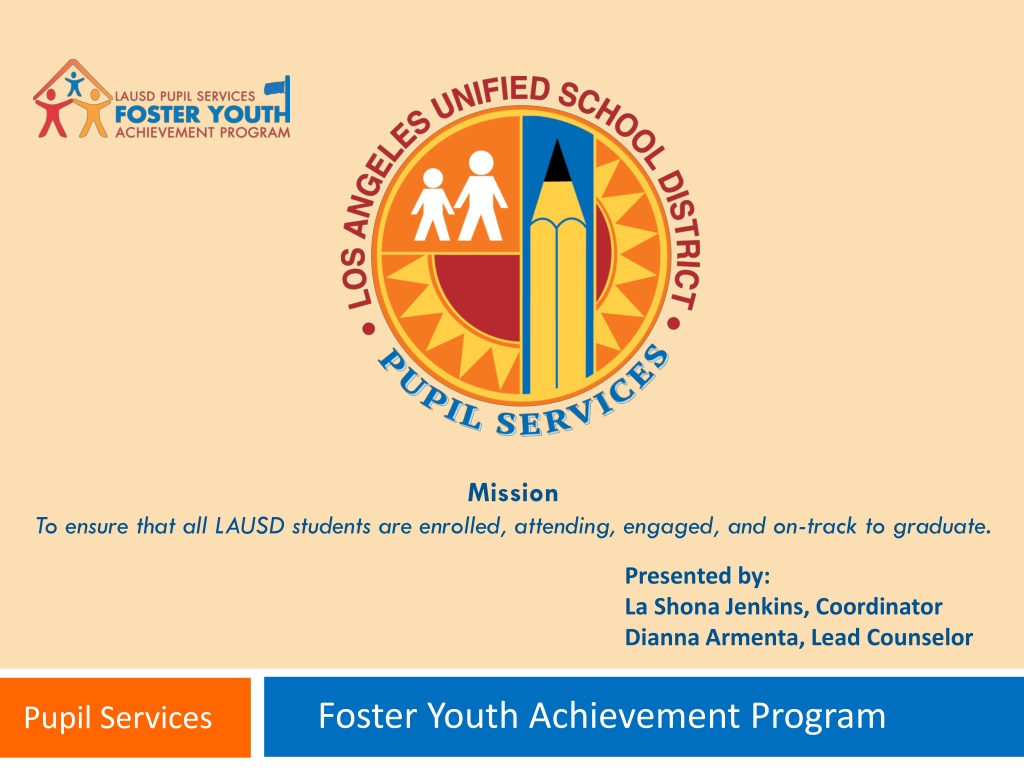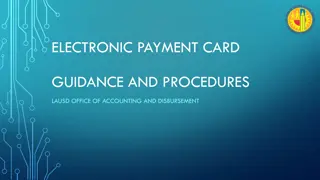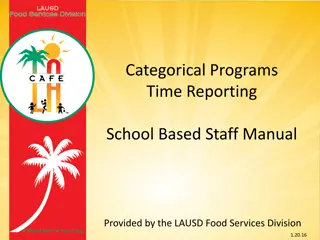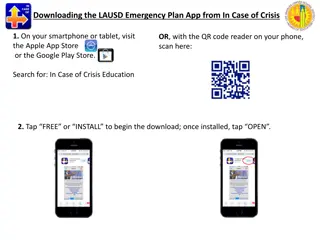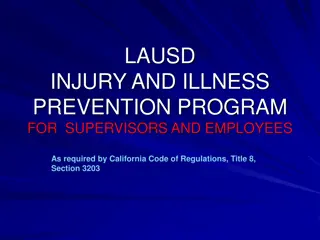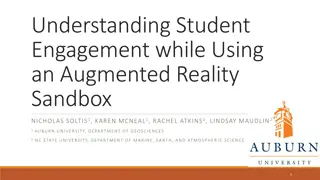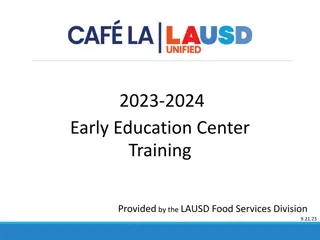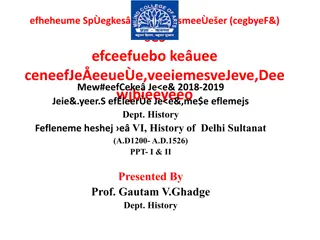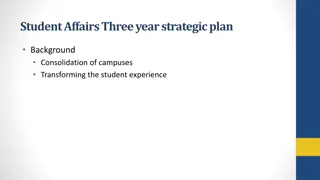LAUSD Student Engagement Guide
This guide presents a comprehensive academic assessment overview and details the completion components of the CAA. It emphasizes the importance of the Individual Success Plan in ensuring student success by addressing concerns and making necessary referrals.
Download Presentation

Please find below an Image/Link to download the presentation.
The content on the website is provided AS IS for your information and personal use only. It may not be sold, licensed, or shared on other websites without obtaining consent from the author.If you encounter any issues during the download, it is possible that the publisher has removed the file from their server.
You are allowed to download the files provided on this website for personal or commercial use, subject to the condition that they are used lawfully. All files are the property of their respective owners.
The content on the website is provided AS IS for your information and personal use only. It may not be sold, licensed, or shared on other websites without obtaining consent from the author.
E N D
Presentation Transcript
Mission To ensure that all LAUSD students are enrolled, attending, engaged, and on-track to graduate. Presented by: La Shona Jenkins, Coordinator Dianna Armenta, Lead Counselor Foster Youth Achievement Program Pupil Services
Comprehensive Academic Assessment Overview Comprehensive Academic Assessment and other FYAP Forms Logging CAA and other FYAP forms onto SOS logs Organization of CAA files Prioritizing your caseload Pacing Plan
Comprehensive Academic Assessment (CAA) and other FYAP forms The CAA helps counselors ensure that students receive the support needed to succeed in school by: gathering student s academic, attendance, and social/emotional history identifying areas of concerns making necessary referrals to address those concerns monitoring students progress and outcomes assessing the impact of the services and interventions provided
Completion Of CAA: Gathering Student History Gather Information from: Current and/or previous teachers Academic counselor Caregiver/Parent Children Social Worker (CSW) Student (secondary) Principal/Administrative Designee SHHS personnel (PSA/PSW/Nurse, etc.) MiSiS MyData Cumulative Record
CAA Completion Components CAA- 2015-2016 9-9-15.docx Student s Name School Grade Date of Birth LAUSD ID number DCFS Case number All Yes/No sections must contain a check mark All Yes sections must have an explanation box marked Explanation boxes with a date field must be completed 10) Start Date 11) Completed By: <Counselor name> 12) Date Completed 1) 2) 3) 4) 5) 6) 7) 8) 9)
Individual Success Plan (ISP) The ISP section of the Comprehensive Academic Assessment allows the Foster Youth Counselor to make appropriate referrals for services that address any identified concerns. The ISP must be completed for all students on your caseload.
Individual Success Plan This section will allow you to indicate concerns, referrals, goals, and outcomes All indicated at-risk indicators/noted concerns from the CAA must be marked in the ISP Refer to CAA to ensure referrals are not duplicated All at-risk indicators/noted concerns must have a goal Goals should be made for students even if the student does not have any at-risk indicators/noted concern Monitoring student progress and outcomes. Use progress notes to record any follow up. It is important to monitor student progress, as LAUSD will aggregate foster youth data in order to track and report the effectiveness of its efforts, which is required under Local Control Funding Formula (LCFF).
Early Education Supplemental Form: Completion Components This supplemental section should be completed for all students up until the time they enter transitional kindergarten or kindergarten. It provides information on early education history, referrals and intervention history, parent/caregiver and teacher concerns. Student s Name School Grade Date of Birth LAUSD ID number DCFS Case number All Yes/No sections must contain a check mark All Yes sections must have an explanation box marked Explanation box with date field must contain a date Start Date 10) Completed By Counselor s name 11) Date Completed 1) 2) 3) 4) 5) 6) 7) 8) 9)
High School Senior Supplemental Form Completion Components The High School Senior supplemental section of the Comprehensive Academic Assessment form should be completed for all high school seniors. This section helps the Foster Youth Counselor ensure that the student has plans after graduation. Student s Name School Grade Date of Birth LAUSD ID number DCFS Case number Transitional Plans section must be marked All Applicable/Not applicable sections must contain a check mark All Applicable sections must have subsection completely filled out Start Date 10) Completed By Counselor s name 11) Date Completed 1) 2) 3) 4) 5) 6) 7) 8) 9)
Progress Notes The Progress Notes section of the Comprehensive Academic Assessment allows the Foster Youth Counselor to document contacts, referrals, interventions, follow-ups, and review/monitoring of records.
Summary of Services (SOS) Log Drop down codes for forms: Yes: The form has been completed. In progress : The form is pending information. No: The form has not been started. Yes, Transferred Completed : A former FYAP Counselor completed the form. Current FYAP counselor must document on SOS log, in order not to double count the completion of required FYAP forms. Former FYAP Counselor leaves yes on SOS logs. No-Transferred in-progress : The former FYAP Counselor did not complete the form. Current FYAP counselor can document on SOS log, once completed it can be changed to yes . Former FYAP Counselor indicates on SOS logs No, Transferred, in- progress , in order not to have pending forms to complete. N/A: Indicates that the form does not apply.
Pacing Plan Complete a minimum of 1 CAA daily Program Goal is to have 60 CAAs completed by each counselor before December 18, 2015 Program Goal is to have 100% completed by each counselor before February 26, 2016
Prioritizing Your Caseload Prioritize your caseload by identifying the number of risk factors a student has. The more risk factors a student has, the higher ranking priority the student has on your caseload. Examples of Examples of Elementary Elementary Risk Factors Risk Factors Examples of Examples of Secondary Secondary Risk Factors Risk Factors Majority of 1s/2s Basic, Below Basic, Far Below Basic attendance (< 92% attendance) Below average statewide testing Disciplinary actions, referrals, suspensions School Instability frequent school transfers Off track to graduate Less than 2.0 GPA (middle and high school) Basic, Below Basic, Far Below Basic attendance (< 92% attendance) Below average statewide testing Disciplinary actions, referrals, suspensions, continuation school placement School instability frequent school transfers
WHEN IN DOUBT, CONTACT YOUR LEAD COUNSELOR OR SPECIALIST! QUESTIONS?
